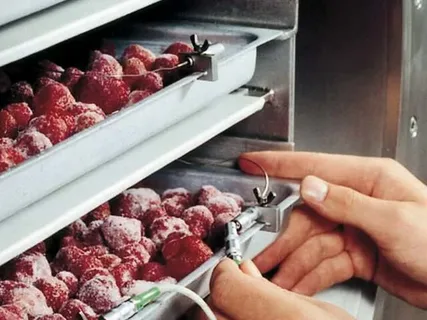Setting up a meat rail system is a critical step in establishing a new abattoir in Ireland. These systems are integral to modern abattoir meat handling, ensuring operational efficiency and compliance with strict industry standards.
By implementing a well-designed meat rail system installation, you not only enhance workflow but also ensure the highest levels of hygiene and sustainability in meat processing.
This guide provides an in-depth overview of the essential considerations, key equipment, and expert tips for setting up a meat rail system tailored to the needs of Irish abattoirs.
The Importance of Meat Rail Systems in Abattoirs
Why Meat Rail Systems Are Indispensable
Efficient abattoir meat handling relies heavily on the integration of a functional and reliable meat rail system. These systems offer numerous advantages, including:
- Operational Efficiency: Automating the transportation of carcasses significantly reduces manual labor, allowing faster throughput and improved productivity.
- Hygiene and Safety: By keeping carcasses suspended, these systems minimise contact with surfaces and reduce the risk of contamination.
- Space Optimisation: Overhead systems maximise the usage of available floor space, freeing up room for essential equipment and personnel movement.
- Consistent Quality: Uniform processing and handling ensure that every carcass meets the high standards required in the Irish meat industry.
Tackling Industry Challenges
Without a robust meat rail system, abattoirs may face numerous challenges, such as:
- Increased manual effort leading to workforce fatigue.
- Slower processing speeds are affecting operational output.
- Greater risk of contamination and hygiene violations.
- Difficulty in meeting strict Irish regulations for meat handling.
Essential Considerations Before Installation
Assessing Facility Requirements
When planning your meat rail system installation, a thorough evaluation of your facility’s needs is paramount. Key factors to consider include:
- Processing Capacity:
- Estimate the daily number of carcasses your abattoir will handle.
- Design a system that can handle peak loads without compromising efficiency.
- Available Space:
- Ensure the system integrates seamlessly into the existing or planned layout of your facility.
- Consider the height and length of rails needed for optimal functionality.
- Budgeting:
- Account for the costs of high-quality abattoir equipment in Ireland, installation, and maintenance.
- Plan for potential upgrades or expansions in the future.
Compliance with Irish regulations is a cornerstone of successful meat rail system installation. Ireland adheres to stringent food safety and hygiene standards, governed by both national and EU legislation.
Key Regulations to Consider:
- European Communities (Food and Feed Hygiene) Regulations 2009 (S.I. 432 of 2009): Alongside the 2020 revision (S.I. 22 of 2020), these regulations implement the EU Hygiene Package into Irish law, ensuring comprehensive food safety measures.
- Regulation (EC) No 852/2004: Requires systems that prevent contamination and maintain hygiene throughout the processing chain.
- Regulation (EC) No 853/2004: Outlines standards for meat of animal origin, focusing on structural integrity, sanitation, and temperature control.
- Regulation (EU) 2017/625: Governs official controls and inspections to verify adherence to food safety standards.
Practical Implications:
- Hygiene Focus: Meat rail systems must suspend carcasses to prevent contact with surfaces, ensuring compliance with hygiene requirements.
- Inspections: Facilities are subject to regular inspections by the Department of Agriculture, Food and the Marine (DAFM) to ensure adherence to these regulations.
- Structural Integrity: Systems must meet load-bearing and operational standards to ensure safety and reliability.
By aligning your meat rail system installation with these regulations, you can achieve operational excellence while safeguarding public health and maintaining compliance with Irish and EU standards.
Designing Meat Processing Systems for Optimal Performance
Customisation for Tailored Solutions
A well-planned system tailored to your needs can significantly enhance performance. Explore options such as:
- Modular Rail Systems: Offer flexibility for future expansions or reconfigurations.
- Automated Technology Integration: Incorporate digital tracking systems to monitor carcass movement and streamline operations.
- Specialised Rails: Use rails designed for specific carcass weights, sizes, and processing stages.
Partnering with Industry Experts
Collaborating with specialists in designing meat processing systems ensures:
- Optimal layouts that maximise productivity.
- Precise installations that avoid delays and errors.
- Ongoing support for maintenance and troubleshooting.
Engaging experienced professionals helps avoid costly mistakes and ensures your system meets both operational needs and compliance requirements.
Selecting the Best Abattoir Equipment in Ireland
Investing in durable, reliable abattoir equipment in Ireland is critical to the success of your facility. Consider the following when selecting equipment:
- Materials: Choose stainless steel or other robust materials to withstand long-term use and repeated cleaning.
- Maintenance: Opt for equipment that requires minimal upkeep but offers easy access for cleaning and servicing.
- Energy Efficiency: Select systems that reduce power consumption, such as motorised rails with low energy requirements.
High-quality equipment not only ensures compliance but also reduces downtime, improves productivity, and saves on long-term operational costs.
Installation Tips for Meat Rail Systems
Pre-Installation Essentials
Proper preparation is vital for a smooth meat rail system installation. Key steps include:
- Conducting structural assessments to ensure ceilings and walls can support the system.
- Laying out a clear plan for rail placement and flow.
- Verifying that all equipment and components are delivered and ready for assembly.
Installation Best Practices
Follow these abattoir and slaughterhouse installation tips for a flawless setup:
- Use skilled technicians to oversee the installation process.
- Test the system rigorously before initiating full-scale operations.
- Involve your team in the setup phase to familiarise them with the system.
Ensuring Long-Term Success
Maintenance and training are critical to keeping your system running smoothly:
- Schedule routine inspections to check for wear, damage, or misalignments.
- Train employees on proper operation to avoid misuse or accidental damage.
- Maintain an inventory of spare parts for quick repairs and minimal downtime.
SUMMARY
Setting Up for Success
Establishing a reliable and efficient meat rail system installation is a transformative step for new abattoirs in Ireland. By focusing on high-quality abattoir equipment in Ireland, adhering to strict designing meat processing systems principles, and leveraging expert abattoir and slaughterhouse installation tips, you can create a facility that meets industry standards while ensuring sustainability and profitability.
Investing in a well-designed meat rail system not only enhances your operational capabilities but also sets the foundation for long-term success in the competitive world of meat processing.








